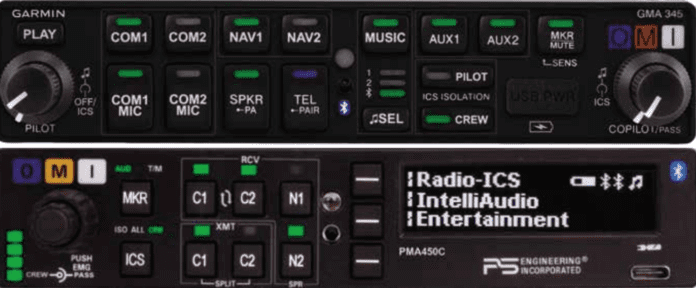
With Garmin’s popular GMA 340 reaching the end of its service life (Garmin’s Service Advisory 21115, rev. C spells it out), there’s a brisk market for slide-in replacements. Garmin’s GMA 345 and PS Engineering’s PMA450C do just that, while stepping up the audio control capability to a high level.
For the customer who doesn’t know better, we hear that many shops fall short in not even offering customers the PS Engineering option, let alone a good demo—which we think shortchanges the buying decision. Since these units perform so many functions, you need to try them before you buy them.
That’s what we did, plugging into both units side-by-side on our test bench. One takeaway is that a built-in function display helps tame the task of customizing the settings.
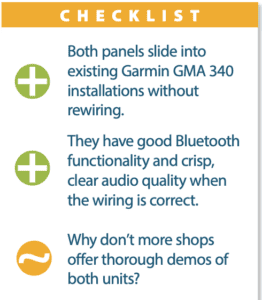
FEATURE RICH
Both of these panels impress, and first-gen audio panels are archaic in comparison. From configurable Bluetooth and music distribution, to how you spatially process various audio sources digitally positioned in the headset, the user experience is pleasing. For some who struggle with button pushing, there’s a learning curve.
Both the PMA450C and GMA 345 (they have six-place intercoms and support multiple radios) are appropriate for replacing Garmin’s extinct GMA 340 with minimum if any rework, assuming the old panel was wired correctly. Neither of these high-quality panels will work we’ll with substandard wiring.
Before we begin, we’ll say that if you have the Garmin GTN 750 TXi navigator, Garmin’s remote GMA 35C audio panel (and panel-mounted 350C) with Telligence voice command and onscreen audio control is worth considering. The remote version saves panel space and further automates the GTN TXi feature set. We’ll look at that interface in a separate article.
Here we’ll concentrate on the GMA 340 direct replacements by running through a handful of functions you might use the most, starting with controlling the radios.
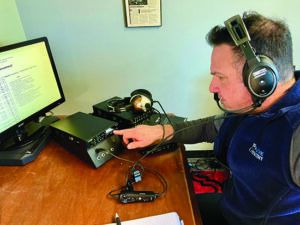
With modern audio panels costing north of $2000 (and as much as $5000 installed), the quality of the audio—particularly Bluetooth and wired radio inputs—is just as important as user features. I want crisp, noise-free and failsafe communications. Saddled up on my bench, I found both PS Engineering’s PMA450C and Garmin’s GMA 345 to be superstars. To help eliminate AC noise, I plugged both demo boxes into my Furman power strip—the same one I use in the recording studio with my electric guitar rig. I sampled each panel with Bose A20 and Lightspeed Delta Zulu noise-canceling headsets (and a passive Clarity Aloft in-ear model) set to stereo mode. I piped Bluetooth audio in from my new iPhone and wired entertainment audio from an MP3 player and newer iPad. Several pilots who plugged in to the intercoms told me both audio panels produced the best-sounding audio they ever heard. Cabin audio has come a long way.
PS Engineering’s 450C uses the company’s IntelliVox automatic squelch control, sampling the ambient noise captured by all six microphones on the intercom and blocking non-voice signals. IntelliVox impresses me as much today as it did when it appeared on PS Engineering’s vintage audio panels.
Garmin’s ASQ, for Avionics Squelch, works to reduce background noise in the GMA 345, while intercom squelch triggering thresholds are set automatically. When it comes to music input quality, Garmin’s GMA 345 has a music equalizer feature (activated by pressing the music Select and Pilot bezel keys) where classical, pop or rock EQ settings are available. There’s also the Music Bass Boost feature (press music Select and Crew keys) for medium or high boost. Both the EQ and Boost can be disabled. These are high-end features that might be better served with a dedicated function display so you know exactly what settings are selected, but with high-end headsets, they sure make the music over the intercom sound good. —Larry Anglisano
BUTTONS, KNOBS, RECORD
For basic radio switching and transmit functions, we think most users can power up the PMA450C and GMA 345 and use them without reading the manual.
• Radio, ICS control: For these basic chores, both units have well-labeled hard keys that have a positive, high-quality tactile feel. The 450C reserves six hard keys to radio receive/transmit functions. There’s C1, C2, N1 and N2 for selecting each, and Garmin does the same.
On the PMA450C, the small inner rotary knob adjusts the intercom volume for the pilot and copilot and the larger outer knob adjusts the passenger intercom volume. Green bars to the left of the knobs will light up when you turn the knobs, showing you the relative volume of the intercom station you’re adjusting. Music volume is controlled through a dedicated Entertainment softkey, where an LED volume bar and numeric volume value show on the screen.
On the Garmin, the left inner rotary knob controls the pilot’s intercom volume and the right inner knob controls the copilot and passenger’s intercom volume. Music volume for the pilot is controlled by the left outer knob and copilot and passenger music volume is on the right outer knob.
• Split comm: This is where the pilot can transmit on radio one and copilot on radio two. On the 345, simultaneously press Com1 and Com2 mic keys. Do the same on the 450 and if you want to talk with the copilot on the intercom, press the ICS button and select CRW, for crew mode. You can’t talk with the passengers while in Split mode.
• Digital recorder: The PMA450C has an internal recorder that stores the last incoming audio from the radio you have selected for transmit. It can store as many as eight incoming messages, and up to 45
seconds of audio. Both the pilot and copilot hear the playback. We like that the 450C’s OLED (Organic Light Emitting Diode) display shows a status message to indicate that playback is in progress. The playback stops when there is more incoming audio from the selected comm radio. To cancel the playback, press and hold the Com receive button for two seconds. The next time the button is pressed for one second, the next earlier message is retrieved.
Garmin’s GMA 345 records up to 60 seconds of the selected comm radio signal on separate memory blocks. Pressing the Play key once plays the recorded memory block. Pressing the MKR/Mute key during playback stops the recorded audio, and it will stop if there’s incoming radio chatter. Once 60 seconds of recording time is up, the recorder begins recording over the stored memory block, starting from the oldest block.
BLUETOOTH, WIRED INPUTS
This is where both of these units shine, and one good reason for upgrading. PS Engineering was the first to bring Bluetooth to an audio panel and the PMA450C takes Bluetooth to the highest level yet. Remember, it’s not just Bluetooth music you’ll use. Audio from ForeFlight, Garmin Pilot and FlyQ apps, to name just a few, have wireless audio alerts that stream to these panels and we like the way the PMA450C’s function display handles the configuring. More in a minute.
First, the 450C has dual Bluetooth modules (BT1 and BT2), and you’ll connect to either of them automatically when pairing. We like that when the Bluetooth is paired, Bluetooth icons and the battery status of a device (smartphones only) are displayed in the upper right corner of the home display. The panel can be paired with up to eight individual devices and will automatically reconnect with the first two it finds. When more than eight are paired, the PMA450C will drop a device to allow the new device to be added.
You can talk in full duplex mode with a connected smartphone, plus the panel’s display shows the incoming caller when caller ID is available. Simply answer the call (and hang up) by pushing the top line-select key. Everyone on the intercom hears the telephone call when the intercom is in All mode and only the pilot and copilot are connected when the intercom is in Crew mode. When the intercom is in pilot isolate (ISO), only the pilot can talk on (and be heard on) the phone.
The GMA 345 has a total of four telephone/entertainment inputs. Turn the music on and off with the dedicated Music key, and change sources with the music select bezel key, which has selections for entertainment input one, input two and Bluetooth. There’s also a dedicated Tel (telephone) key, which serves double duty as a Bluetooth pairing control.
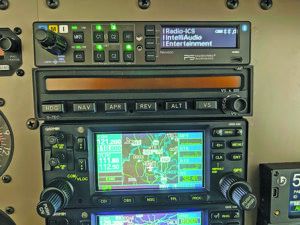
AUDIO DISTRIBUTION
Perhaps what we like the most is that since the 450C has dual Bluetooth modules, BT1 can be connected to a smartphone and the BT2 connected to a tablet for app alerts. Moreover, when in pilot isolation (ISO) mode, the music for the pilot is automatically disabled, but the pilot can still select Bluetooth and either audio input source (using the Entertainment line select key on the display). This is a good way to isolate passengers from startling traffic and terrain alerts. We think this is a major advantage.
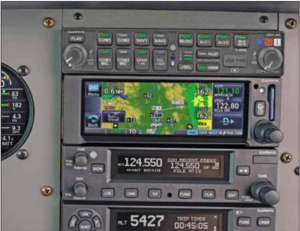
The PMA450C’s Entertainment line key has three choices: Mute mode, Distribution mode and Music Volume setting. This Entertainment menu is where the 450C really shines. The pilot can select from a variety of wireless and wired input sources—BT1, BT2, BT1 and BT2, Music1 (a wired input) and BT1 and Music1 and just BT2. The copilot has the same flexible settings. The passengers can listen to Music1, Music 2, BT1 or BT2. That Music 1 might be a wired Garmin GDL 69A SXM receiver, or even a music input jack in the cabin, for example. The pilot, copilot and passengers can select individual volume levels for whatever sources they are listening to.
The 450C has expanded source muting options when there are radio calls. For instance, the pilot probably wants everything to mute and maybe the copilot doesn’t want anything to mute. There are a total of 27 different source and muting combinations.
The GMA 345 has four telephone/entertainment inputs, and the music Select key is how you choose the music sources. It also has three aux inputs, controlled with dedicated Aux1 and Aux2 bezel keys. Traffic and engine monitoring outputs are two sources that can be wired in. These keys also alternately function (by pressing and holding) to mute passengers and music on the intercom.
On the PMA450C, we like that you use the display to custom name the switched inputs as dedicated line items, with a maximum of nine letters per line. Numbers and even lowercase letters are available. Again, the value of a dedicated display is obvious.
You’ll need to bring along Garmin’s quick reference card to perform many of the alternate key functions, and some secret handshakes are ones you wouldn’t expect, like playing and pausing the Bluetooth media by simultaneously pressing Nav2 and Music key. Or skip to the next song in your music track by pressing Nav2 and the Aux2 keys. In our view, controlling the Bluetooth media from the original source might be easier for some.
DIMENSIONAL SOUND
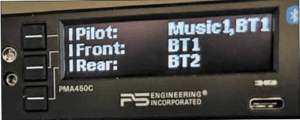
To spatially hear multiple audio sources in stereo headsets, Garmin calls it 3D Audio and PS Engineering calls it IntelliAudio. This creates the illusion that each audio source is coming from a unique seat position or cabin location.
In the PMA450C, when IntelliAudio is turned on by selecting the lower line select key (there are four modes—On, Off, Auto and Monitor) radio communications are digitally processed at the 10 o’clock position (for the primary radio) and the 2 o’clock position for the secondary radio. The intercom and other in-panel audio aren’t spatially processed. The positions are fixed (not configurable) but the flagship PMA450B enables you to move the radio sources around via the set’s Head Related Transfer function.
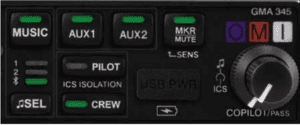
But IntelliAudio is still smart in the scaled-down 450C. In Auto mode, IntelliAudio reverts to normal (straight ahead) when one of the radios is quiet for one second. The spatial separation will return as soon as both radios are active. The Monitor mode mutes the second radio’s audio when the primary radio breaks squelch so you don’t miss a call. For instance, maybe you’re fetching ATIS on the second radio and you get a call on the primary one that’s also selected for transmitting.
Don’t expect dimensional sound to work with mono headsets for either of these audio panels, although you’ll still hear all of the audio sources. With a single comm radio and 3D Audio enabled, Garmin’s GMA 345 places the audio at the 12 o’ clock position, and all other intercom positions are processed to sound like their relative seat location. And unless the installer makes the change in the configuration mode, the GMA 345 assumes the pilot is sitting in the left seat.
TRY THEM YOURSELF
This is just a small sample of some of the major functions built into these two feature-rich panels (and how the very different feature sets work), and we can’t come close to covering every feature in a single article.
We strongly suggest plugging into both of them for a thorough demo before making the decision. Garmin’s GMA 345 is $2245 and the PS Engineering PMA450C with marker beacon receiver is $2595. The version without marker beacon is $2495.
As we said, we think PS Engineering has the advantage with its function display because it allows more audio distribution options that you simply can’t effectively achieve with alternate key functionality.
But that’s not to say that Garmin’s GMA 345 doesn’t have a smart feature set and intuitive control logic—it’s just different. But only you know what you’ll get along with better, based on how seamlessly you can work with the features that are most important to you.
Visit www.garmin.com and www.ps-engineering.com.

